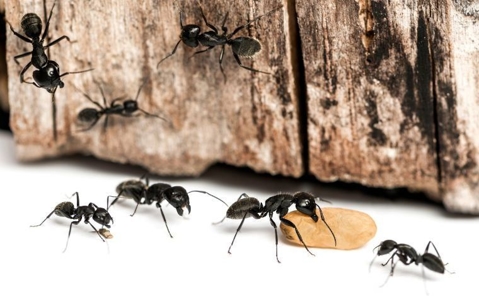What Do Carpenter Ants Look Like?
Carpenter ants are large ants, typically ranging in size from ¼ to ½ inch long, though queens can grow even larger, up to ¾ inch. Their appearance varies slightly depending on the species, but they generally have the following characteristics:
Color: Most commonly black, but some species have reddish or brownish hues, particularly on the thorax.
Body Shape: Like all ants, they have a three-segmented body (head, thorax, and abdomen) with a narrow "waist" between the thorax and abdomen.
Antennae: Bent (elbowed), not straight like those of termites.
Mandibles (Jaws): Strong and well-developed for chewing wood, though they do not eat it.
Wings (Reproductive Members Only): Winged carpenter ants, known as swarmers, emerge to mate and start new colonies. They are often mistaken for termites but can be distinguished by their narrow waist and differently sized wings (front wings longer than hind wings).
Carpenter ants are frequently found in moist or decaying wood, where they excavate tunnels to build their nests. Unlike termites, they do not eat wood but hollow it out, which can cause structural damage over time.
Learn more: Carpenter Ants vs Termites
How Big Are Carpenter Ants?
Carpenter ants (Camponotus species) are among the largest ants found in North America. Their size varies depending on their role within the colony:
Workers: Typically range from ¼ inch to ½ inch (6-13 mm) long. Carpenter ant colonies have polymorphic workers, meaning there are different sizes within the worker caste.
Soldiers: Larger workers (also called major workers) can grow up to ½ inch (13 mm) or slightly more.
Queens: The largest individuals in the colony, reaching ¾ inch (19 mm) or more.
Carpenter ants are often mistaken for termites, but they can be identified by their narrow waists, bent antennae, and shiny black, reddish, or brown coloration. While they do not eat wood, they excavate it to create nests, which can lead to structural damage over time.
What Color Are Carpenter Ants?
Carpenter ants (Camponotus species) come in a variety of colors, depending on the species. The most common colors include:
Black – Many species, such as Camponotus pennsylvanicus (one of the most common in North America), are completely black.
Red and Black – Some species have a red or reddish-brown thorax with a black head and abdomen.
Brown – Certain species are entirely brown or dark brown.
Yellowish or Tan – Less common but found in some tropical or desert species.
Despite their color variations, all carpenter ants share similar characteristics, such as a narrow waist, bent (elbowed) antennae, and large mandibles used for chewing wood when creating nests.
Learn more: Carpenter Ants vs Black Ants
What Shape Are Carpenter Ants?
Carpenter ants have an elongated, segmented body with a distinct narrow waist between the thorax and abdomen. Their body shape consists of three main parts:
Head – Large and rounded, with powerful mandibles for chewing.
Thorax (Middle Section) – Slightly narrower than the head and connected to the legs.
Abdomen – Oval or elongated, often slightly pointed at the end.
Their overall shape is similar to other ants but can appear more robust due to their large size. One of the key distinguishing features is their pinched waist (petiole), which helps differentiate them from termites, whose bodies are more uniform and cylindrical.

